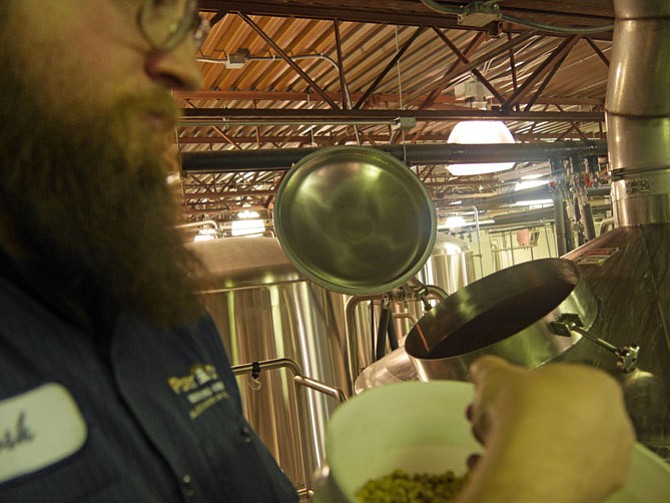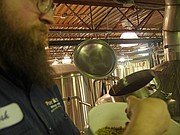Josh Center, brewer at Port City Brewing Company in Alexandria, adds pellets of dry hops to the whirlpool kettle. Different combinations of hops are added to the kettles at different stages of brewing depending on the particular beer. Photo by Shirley Ruhe/Gazette Packet
Music blasts out at Port City Brewing Company on Wheeler Avenue. A row of large, stainless steel kettles lines the platform upstairs, each with a specific purpose in the brewing process. Josh Center bolts down 12 metal steps, jumping the last two.
He is monitoring the hop tone and sees the island break in the boil kettle so races downstairs to switch the drain off to the second set of pipes. Then he bounds back up the steps to check the board of multi-colored lights, in this case monitoring the flow of splurge water in the 30 BBL brew kettle that should be coming in and going out at the same rate.
"O.K., he says, "13.5 gallons per minute." A heavy pungent smell sits in the air over the brew kettle where the grains are mashed for about an hour with water. All Port City beers begin with the same base malt, a Canadian pilsner, "and we add specialty malts to get different flavors, colors, aromas. Aroma and mouth feel are very important for a beer, just like cooking." The spent grain goes to farmers for livestock, "or sometimes I take home a little.” Center says, “It makes excellent bread."
It is mid-morning which is the busy time during the 3-4 days a week when brewing takes place. A forklift moves back and forth across the concrete floor carrying pallets of empty beer bottles. The whole process of making this batch of beer will take 2-3 weeks. When starting a new brew, Center says they begin with a 10-gallon tank, see what they think and then tweak for a second brew and then a third tweak before they work up to their full brew, After the sparging (rinsing) step, the wort (liquid) moves to the boil kettle. "If we are making the Monumental IPA, we add hops all through the 1.5 hour boil process, then throw in a decent size at the end to get out all of the flavor."
He walks the few steps to the whirlpool kettle where the liquid will sit for 10 minutes. Center opens the lid to throw in some dry pellet hops from a large white bucket. He says that different hops can be added at this stage depending on the beer that is being made. And, he adds, if they are making the Optimal Wit beer, a large "tea bag" of spices with orange peel, coriander and grains of paradise is lowered into the tank on a rope, "just like you're making tea." The next step is the fermenter with a conical bottom to collect the yeast. The beer spends a week or so here in primary fermentation. When the yeast has eaten up enough of the sugars, they seal up the tank to build up pressure and begin the process of carbonation. Last step is the bright tank where natural filtration takes place resulting in the clarity of beer. "From here it goes to bottles or kegs depending on demand for certain beers."
Center disappears momentarily down the steps again, throwing words back over his shoulder, "Woop, have to stop it, don't want it to clog." Center says, “I am a paranoid brewer. I like to go around and check all of my valves."
He said that everything is manual, all the system valves and tubes at Port City. Some large breweries have everything computerized. He stops to check on the temperature again, "real quick." He says, "In the beginning I was worried I would open the wrong valve and send all of the hot beer down the drain. But eventually it becomes like a dance." He says, "We try very hard to take readings and taste at all points to be sure it is within the range of all the other batches we have been tasting but he emphasized, "we don't taste it all on the same day."
Center starts work at 5 a.m., and Adam Reza comes for the second shift at 1 p.m. Center says that he and Adam came up with their first beer last year. It is a black IPA that "gets its roastiness from dark malts. We wanted a centennial hop." He says the beer went through three pilot batches in the public tasting room. As with all tests, it was labeled "suspicious package." It was ready to be served at Halloween.
Center has been at Port City for two years. He said he learned on the job but it helped that he had been a home brewer before he was hired. He says he never quite got the knack of it until he "got trained by professionals here." Center has disappeared. Time to check the valves one more time.



